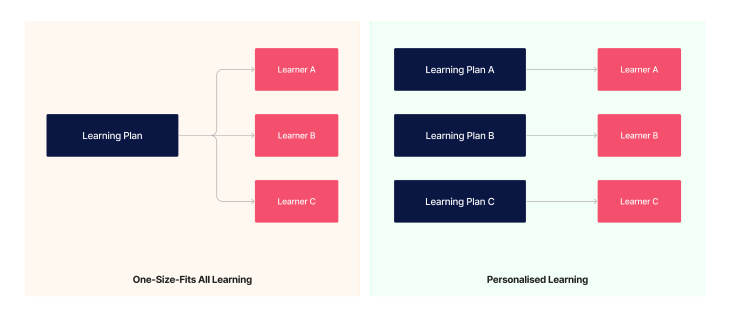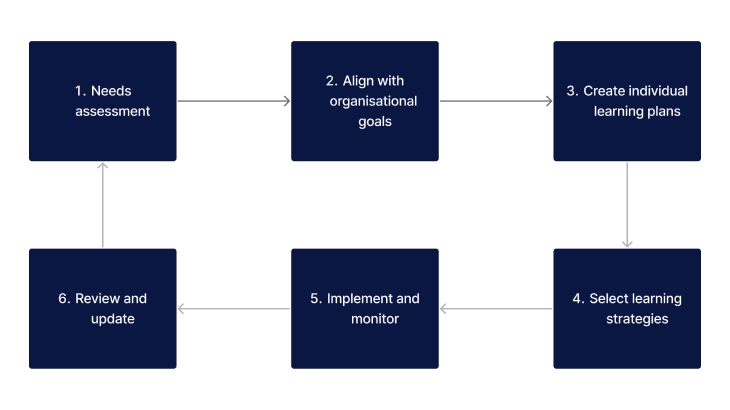The Australian healthcare system is continuously evolving, making ongoing education a necessity for healthcare professionals. Learning and development managers are increasingly turning to training modules to meet these educational needs. In this article, we'll explore the various aspects of creating effective training modules for employees in healthcare.
What is Personalised Learning?
Personalised learning is an educational model that puts the learner at the centre of the instructional process. Unlike traditional methods that employ a one-size-fits-all approach, personalised learning customises educational experiences based on individual needs, skills, and interests. Learning strategies are specially designed to align with individual learning plans, ensuring that education is not just a passive process, but a collaborative effort between the learner and the educator.
What is Personalised Education in Healthcare?
In the realm of healthcare, personalised education takes on an even more crucial role. Here, the stakes are higher because the quality of education directly impacts patient care. Individual education plans are meticulously developed for health professionals to suit their specific roles, skills, and the unique health conditions they may encounter. Whether it's a nurse working in aged care or a disability support worker, each professional's educational journey is uniquely tailored. This is particularly relevant in Australia’s complex healthcare settings, which span across public and private hospitals, aged care facilities, and disability care services.

Why is Personalised Learning Important?
Personalised learning is vital for a multitude of reasons, particularly in the healthcare sector (Australian Commission on Safety and Quality in Health Care, 2020). It fosters staff learning and professional development by acknowledging the diversity of learner needs and preferences (NDIS, 2021). Given the multifaceted nature of Australia’s healthcare system, a one-size-fits-all approach can be not only ineffective but also resource-intensive. Personalised learning ensures that the health professionals are trained in the most efficient manner possible, better equipping them to deliver quality healthcare services.
Examples of Personalised Education
Creating your own training modules involves several key steps. Here’s a more in-depth look:
- Aged Care: A nurse might focus on courses specifically related to geriatric syndromes, palliative care, and medication management (Aged Care Quality and Safety Commission, 2019).
- Public Health: A public health officer working on disease prevention could have an individual learning plan focused on community health, epidemiology, and public policy (Medicare Australia, 2021).
- Disability Care: healthcare workers and disability staff might concentrate on behavioural management techniques and adaptive technologies that enhance the quality of life for people with disabilities.
What Are Personalised Learning Strategies
Developing effective learning strategies is pivotal in actualising personalised education. These strategies often involve blended learning approaches, combining digital and physical educational resources. Moreover, using real-time data can help in dynamically adjusting the learning paths. For example, if an aged care worker is consistently performing poorly in a particular module, the Learning Management System (LMS) can adapt to offer additional resources or alternative instructional methods.
Benefits and Negatives of Personalised Education
While personalised learning is extremely beneficial within the healthcare sector to ensure the unique learning gaps of healthcare professionals are met, they also come with some drawbacks. Here's a look at the positives and negatives of personalised education:
| Benefits | Negatives |
|---|---|
| Higher Engagement Levels: Learners are more invested when the content is relevant to their needs and roles. (Australian Commission on Safety and Quality in Health Care, 2020) | Resource Intensive: Customising education for each individual requires more time and effort from educational staff. (NDIS, 2021) |
| Improved Learning Outcomes: Targeted learning results in better retention and application of knowledge. | Implementation Challenges: Deploying a personalised approach might necessitate overhauling existing curricula and teaching methods. |
| Flexible Learning Paths: Allows for adjustments based on learner performance and changing roles. | Potential for Inequality: Without careful planning, some learners might receive more attention and resources than others. |
| Enhanced Professional Development: Staff can focus on skills directly related to their roles, fostering better job performance. | Requires Continuous Monitoring: The dynamic nature of personalised learning calls for regular assessments and course corrections. |
| Efficient Use of Resources: By focusing on individual needs, education can be more cost-effective in the long term. | Data Privacy Concerns: Collecting individualised data for educational customisation might pose privacy risks. |
Want a healthcare LMS that you can support personalised learning?
Contact Ausmed today and see how we can support your organisation!
How Do I Start Implementing Personalised Education?
Implementation of personalised learning plans requires some effort to get started, but will lead to better learning and organisational outcomes in the long run. Here's how you can begin implementing it in your healthcare organisation:

- Needs Assessment: Conduct a comprehensive survey or assessment to identify the unique learning needs and preferences of your staff. This can include preferred learning modalities, roles, responsibilities, and specialisation areas.
- Align with Organisational Goals: Ensure that the personalised education plan is aligned with the objectives of your healthcare organisation. This can involve consulting stakeholders and referring to the Australian Commission on Safety and Quality in Health Care standards (Australian Commission on Safety and Quality in Health Care, 2020).
- Create Individual Learning Plans: Based on the needs assessment and organisational goals, create an individual learning plan (ILP) or individual education plan (IEP) for each staff member. This should be a dynamic document that can evolve over time.
- Select Appropriate Learning Strategies: Opt for a mix of learning strategies that suit the preferences and needs of the staff. This can range from online courses and workshops to hands-on training and mentorship.
- Implement and Monitor: Roll out the personalised education plans and continuously monitor their efficacy. Use performance metrics, feedback, and assessments to make ongoing adjustments (NDIS, 2021).
- Review and Update: Regularly review the ILPs and IEPs to ensure they remain aligned with individual roles, healthcare system requirements, and best practices. Update them as needed, based on changes in public health guidelines, health conditions, or organisational goals.
What Tools Can I Use to Personalise Education in My Organisation?
- Learning Management Systems (LMS): Comprehensive platforms that offer course creation, distribution, and tracking. Advanced LMS platforms often come with built-in analytics, allowing for dynamic adjustments based on performance metrics.
- Healthcare Databases: Integrating healthcare databases with your LMS can provide educational modules tailored to prevalent health conditions in a given setting.
- Feedback Tools: Utilising surveys and focus groups can provide crucial insights into staff learning preferences and areas of improvement.
- Interactive Platforms: Tools like forums and webinars can facilitate interactive learning and better engagement.
- Adaptive Learning Software: These tools adjust the difficulty and focus of educational material in real-time, based on learner performance.
How to Create Your Own Training Modules on Ausmed?
On Ausmed, you can easily create learning modules and courses with our LMS. The in-built course builder feature supports your ability to create unique training relevant to your staff needs, and allows you to link relevant NSQHS and ACQS standards to support your compliance requirements. Simply follow the prompts to input your content, set your learning objectives, and include interactive assessments to create an effective training module.
Related Resources
- LMS in Healthcare: The Roles, Benefits and Pros and Cons
- What Are Learning Analytics?
- How to Create a Culture of Continuous Learning
- What Are the Best Practices for Learning Accessibility?
- How to Manage an Effective Staff Training Program
Conclusion
Personalised education is pivotal for fostering professional development in healthcare. By understanding its nuances and implementing tailored learning strategies, healthcare organisations can significantly improve patient care and operational efficiency. The challenges are manifold, but the long-term benefits make it a worthwhile investment.
References
- Australian Commission on Safety and Quality in Health Care. (2020). National Safety and Quality Health Service Standards.
- National Disability Insurance Scheme. (2021). NDIS Practice Standards.
- Aged Care Quality and Safety Commission. (2019). Aged Care Quality Standards.
- Medicare Australia. (2021). Medicare Benefits Schedule.



